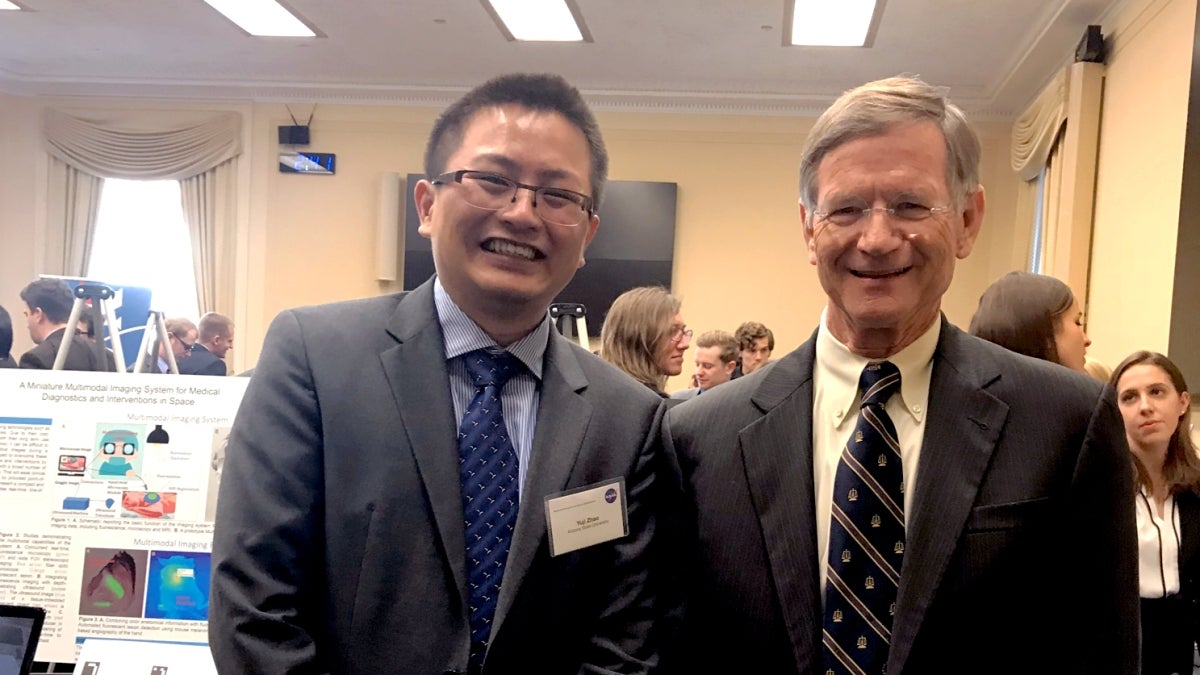ASU engineer showcases NASA research for Congress

Yuji Zhao (left) poses with U.S. Representative Lamar Smith, chairman of the Committee on Science, Space, and Technology. Zhao was one of a select few invited to meet with members of Congress to talk about advances in technology for space applications during the Nov. 29 NASA Tech Day event. Photo courtesy of Yuji Zhao
To help NASA better explore outer space, Yuji Zhao headed to Capitol Hill with NASA’s best and brightest collaborators in academia to talk space tech with U.S. Congress members.
Zhao, an assistant professor of electrical and computer engineering at Arizona State University’s Ira A. Fulton Schools of Engineering, was one of only three faculty members from across the country invited to join NASA’s senior leadership in the nation’s capital for NASA Tech Day on Nov. 29, 2017.
The important research Zhao presented involves high-temperature solar cell technology for missions that head to the very hot planet Mercury.
This is made possible by Zhao’s work with gallium nitride, which has enabled devices such as solar cells to sustain their performance in very high temperatures
“One major breakthrough is we can develop a solar cell that has improved performance over high temperatures, whereas the silicon cells we have now would degrade with higher temperatures,” Zhao said.
Silicon-based solar cells at room temperature (20–25 degrees Celsius, 68–77 degrees Fahrenheit) operate at 80 percent capacity, but at 80 degrees Celsius or 176 degrees Fahrenheit it degrades to 20 percent, Zhao said.
Gallium nitride based solar cells, however, operate at 50 percent capacity at room temperature and all the way at 300 degrees Celsius or 572 degrees Fahrenheit they operate at 80 percent capacity.
“This is quite exciting and we are working with several groups here as well as at Stanford University to figure out the fundamentals behind [gallium nitride],” Zhao said. “The whole result is very interesting and NASA has high regard for those results.”
Zhao has also been using gallium nitride to power electronics as part of research supported by NASA as well as the Department of Energy’s Advanced Research Projects Agency-Energy and the Department of Defense’s Defense Threat Reduction Agency. Zhao has also received the NASA Early Career Faculty Award and participated in the NASA HOTTech Program.
“Yuji Zhao’s expertise and research have positioned the Ira A. Fulton Schools of Engineering as a leader in the emerging uses of gallium nitride, including lighting and photovoltaics,” said Stephen Phillips, professor and director of the School of Electrical, Computer and Energy Engineering. “We’re proud that he was selected by NASA to participate in this exclusive event that showcases important innovations in engineering to Congress.”
NASA officials have also visited Zhao’s Metal-Organic Chemical Vapour Deposition Lab at ASU for a workshop on photovoltaics in December 2016, and in November 2017 Zhao was invited to NASA’s Glenn Research Center in Cleveland — its major research center for high-temperature electronics and photovoltaics for Mercury and Venus missions — to talk about gallium nitride and its role in the future of space technology.

Yuji Zhao (middle row, seventh from left), assistant professor of electrical and computer engineering at Arizona State University’s Ira A. Fulton Schools of Engineering, poses with Steve Jurczyk (middle row, far left), associate administrator of the NASA Space Technology Mission Directorate, and other faculty, students and NASA associates at the NASA Tech Day event on Capitol Hill. Photo courtesy of Yuji Zhao
Zhao’s rich history of NASA-supported research was a major factor that led to his invitation to the NASA Tech Day event. Along with the other faculty members, students funded by NASA grants were also invited to attend.
“NASA wanted to showcase the best research they have supported from the leading universities in the U.S.,” Zhao said.
The event included a poster session, technology demonstrations and talking with members of Congress. Zhao was also able to meet with Lamar Smith, chairman of the committee for space, science and technology and U.S. Representative of the 21st Congressional District of Texas.
He also met with the staff of Kyrsten Sinema, U.S. representative from Arizona’s 9th Congressional District, and Andy Biggs, U.S. representative from Arizona’s 5th Congressional District.
"I enjoyed meeting Dr. Zhao in D.C. last year and learning about critical advances in science and technology at ASU," Biggs said. "Dr. Zhao's work is especially relevant to our aerospace industry, including the aerospace and defense companies in Arizona's 5th Congressional District."
Sinema also noted the value government-research partnerships add to the state's economy.
"Dr. Zhao's work in Tempe shows the value of investment by the federal government into scientific research and the potential significant economic impact that research can have," Sinema said.
Zhao hopes to continue the discussion with local representatives to help foster a relationship between government and academia and support for local engineering and technology efforts — a goal also supported by Kyle Squires, professor and dean of the Ira A. Fulton Schools of Engineering.
“Bringing a technology with interplanetary applications and truly global impacts to the national stage highlights our faculty’s research excellence and the innovative applications enabled by their discoveries, in this case in solar cells and photovoltaics,” Squires said. “We look forward to building upon this connection with Phoenix-area leadership to further advance engineering and technology research and education.”
More Science and technology

ASU and Deca Technologies selected to lead $100M SHIELD USA project to strengthen U.S. semiconductor packaging capabilities
The National Institute of Standards and Technology — part of the U.S. Department of Commerce — announced today that it plans to…

From food crops to cancer clinics: Lessons in extermination resistance
Just as crop-devouring insects evolve to resist pesticides, cancer cells can increase their lethality by developing resistance to…

ASU professor wins NIH Director’s New Innovator Award for research linking gene function to brain structure
Life experiences alter us in many ways, including how we act and our mental and physical health. What we go through can even…